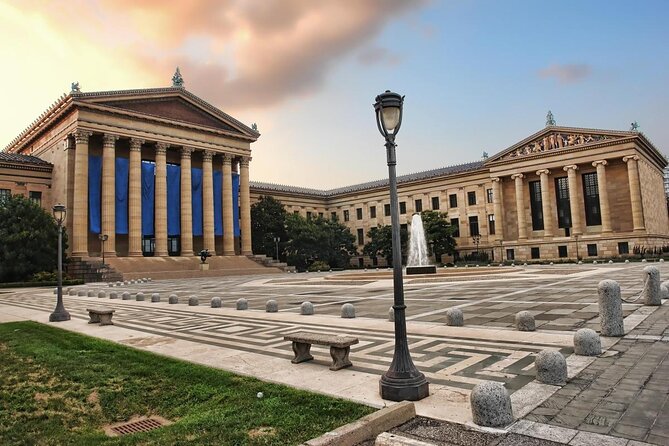All You Need to Know About the Philadelphia Museum of Art
The Philadelphia Museum of Art, internationally recognized, stands proudly in Fairmount Park, Philadelphia. Founded initially in 1876 as the Pennsylvania Museum and School of Industrial Art, it was rechristened to its present title in 1938, symbolizing its broadened scope and aspirations. With a vast collection of approximately 240,000 objects that traverse the entirety of art history, the Philadelphia Museum of Art showcases significant strengths in American, European, and Asian art, positioning itself as a leading museum of art in Philadelphia.
The main building’s completion in 1928 on scenic Fairmount amidst the grandeur of the Benjamin Franklin Parkway, firmly established the Philadelphia art museum as an architectural marvel. It administers a vast range of collections, including sculpture, paintings, prints, photographs, and decorative arts, drawing in an impressive 793,000 visitors in 2017 alone. Under the leadership of Sasha Suda, the museum continues to enrich the cultural landscape of Philadelphia, offering a bridge to art’s past, present, and future.
The Musuem’s Journey Through History

The Philadelphia Museum of Art (PMA) has a rich tapestry of history that underscores its significance in the world of art and culture. Initially chartered in 1876 to commemorate the Centennial Exposition, it has evolved significantly over the years, marking milestones that have shaped its identity. Here are key historical highlights:
- 1876-1899: Foundational Years
- Chartered for the Centennial Exposition.
- Expanded collections to include European ceramics, fine and decorative art, and more.
- Established as the Pennsylvania Museum and School of Industrial Art.
- 1920s-1940s: Expansion and Growth
- 1928: Completion of the main museum building on Fairmount.
- Managed the Rodin Museum and historic houses in Fairmount Park.
- 1930s: Received significant gifts, adopting the new official name.
- 1940s: Introduced the first Costumes Gallery and a new wing for Asian arts.
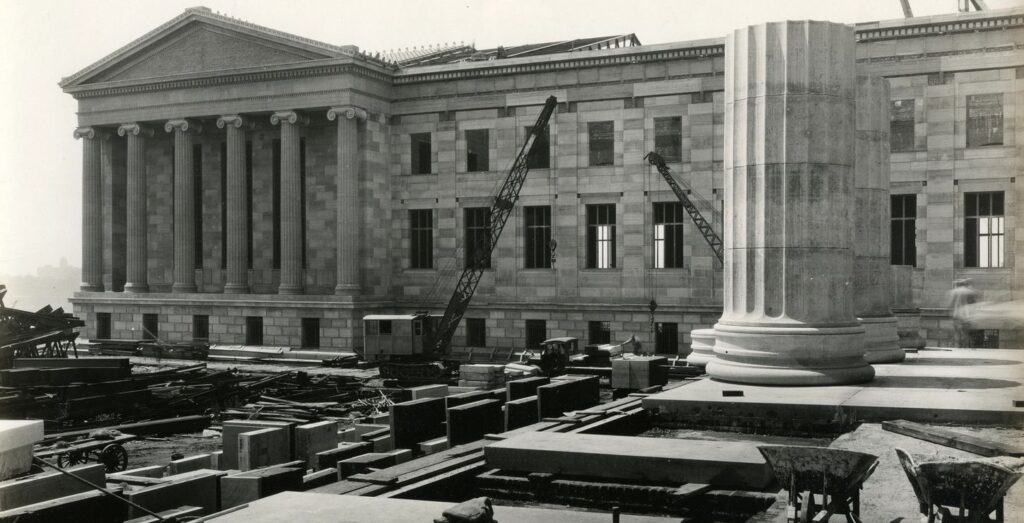
- 1950s-2020s: Modernization and Renovation
- 1950s: Became a hub for early modern masterpieces.
- 1960s-1970s: Focused on conservation and renovation.
- 1980s-1990s: Significant acquisitions and gallery renovations.
- 2000s: Contemporary art galleries renovation and the opening of the Perelman Building.
- 2010s: Major facilities improvements and the introduction of new programs.
- 2020: Navigated the COVID-19 pandemic and unveiled the Core Project with new galleries and spaces.
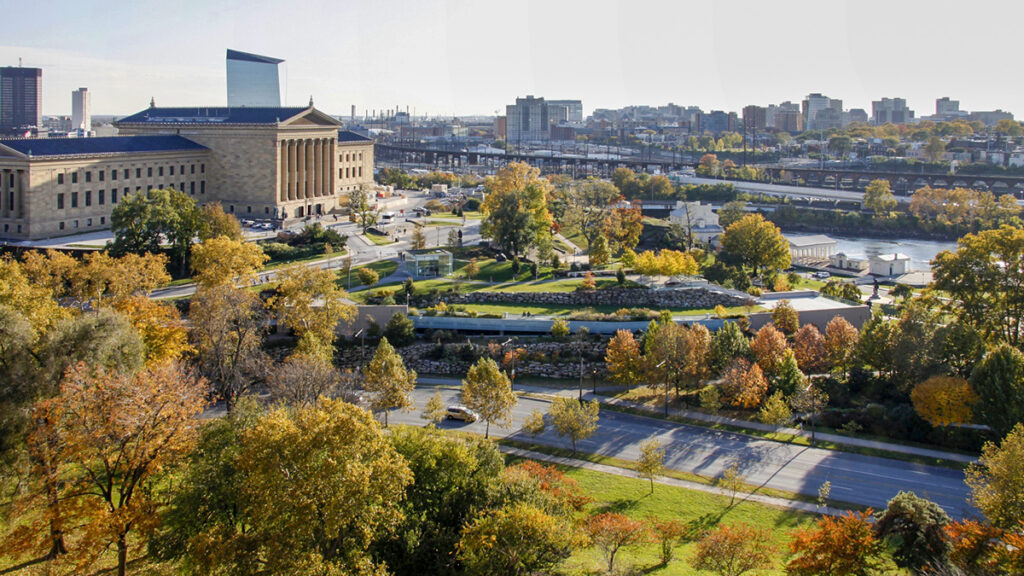
The design and architectural evolution of the museum also tell a story of ambition and vision. The original design was chosen in 1917, with contributions from notable architects and firms. Over the years, the museum has seen several expansions, including the recent Core Project led by Frank Gehry, which has further solidified the Philadelphia Museum of Art’s place as an architectural marvel and a beacon of art in Philadelphia. This journey from its inception to becoming a museum of art in Philadelphia that houses diverse and extensive collections is a testament to its enduring legacy and cultural significance.
Notable Collections and Exhibitions
At the heart of the Philadelphia Museum of Art’s allure are its diverse and expansive collections, which span across various eras and genres, making it a premier destination for art enthusiasts. The museum’s collections are meticulously organized into several subsections, each offering a unique glimpse into the world of art. Among these, The Carl Otto Kretzschmar von Kienbusch Collection stands out for its remarkable assembly of arms and armor, showcasing the craftsmanship and historical significance of these artifacts. Special exhibitions frequently grace the museum, providing visitors with a dynamic and evolving art experience. These exhibitions, such as ‘Mexico and Modern Printmaking, 1920–1950’ and ‘Pop Art,’ offer a deep dive into specific art movements or periods, enriching the visitor’s understanding and appreciation of art.
The Philadelphia Museum of Art is also recognized for its proactive approach in expanding its collection to include more works by underrepresented artists. This initiative has led to a more inclusive representation within the museum’s walls, featuring artists of color, women artists, and LGBTQIA+ artists. Such efforts not only diversify the museum’s collection but also reflect the evolving landscape of art and society. Notable acquisitions and gifts, including those from John D. McIlhenny and Louise and Walter Arensberg, have significantly enriched the museum’s holdings, allowing it to achieve national recognition for its masterpieces of early modern art. The museum’s dedication to sharing its collection with a wider audience is evident through its long-term loans and traveling exhibitions, ensuring that these treasures reach as many people as possible.
In terms of exhibition space, the museum has made significant strides with the creation of two new suites of galleries. The Robert L. McNeil, Jr. Galleries, focusing on early American art, and the Daniel W. Dietrich II Galleries, dedicated to modern and contemporary art, together add 20,000 square feet of exhibition space. This expansion not only accommodates more artworks but also provides a more comprehensive narrative of American art history. The museum’s contemporary art collection, featuring over 1,000 works from 1950 to the present, represents artists from around the globe, including notable contemporary artworks such as Seine by Ellsworth Kelly and Fifty Days at Iliam by Cy Twombly. Through its collections, exhibitions, and publications, the Philadelphia Museum of Art continues to be a pivotal institution in the art world, inviting visitors to explore the rich tapestry of human creativity and expression.
Architectural Beauty
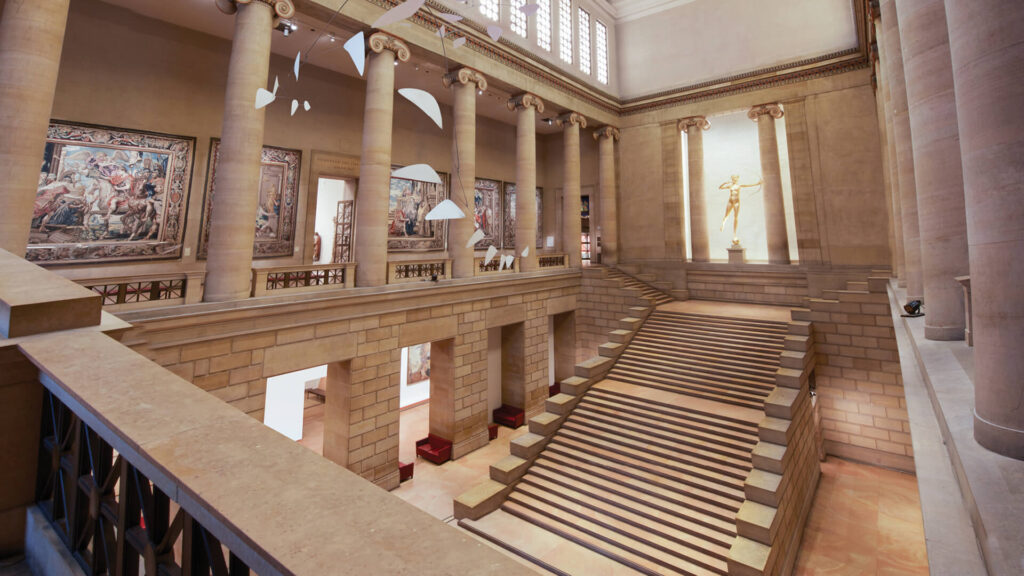
The Philadelphia Museum of Art, completed in 1928, is an architectural marvel that reflects a blend of historical significance and modern innovation. Nestled at the northwest end of the Benjamin Franklin Parkway at Eakins Oval, the museum’s grandeur is immediately apparent. Here are some key architectural features:
- Ionic and Corinthian Styles: The museum’s design incorporates the Ionic style, evident in its overall structure, while the front and rear entrances are adorned with Corinthian capitals, adding to its majestic appearance.
- Strategic Construction: Initially built from the wings inward, this strategy ensured the city could not withdraw funding mid-project, which would leave an unfinished structure. This clever approach underscores the museum’s significance and the commitment to its completion.
- The Core Project: A recent initiative, the Core Project, has reimagined nearly 90,000 square feet of the museum’s space. Highlights include:
- The Robbi and Bruce Toll Terrace and ADA compliant ramps, enhancing accessibility.
- The renovation of Lenfest Hall, welcoming visitors through the principal entrance.
- The creation of the Williams Forum, a new public space fostering engagement and connection across the museum’s levels.
- Restoration of the Vaulted Walkway, now open to the public after nearly 50 years, offering a grand corridor that spans the building’s entire breadth.
The museum’s location atop Fairmount Hill, on the site of a decommissioned reservoir and at the end of the Benjamin Franklin Parkway, further elevates its status as a landmark. The museum’s facade is adorned with a continuous frieze and a pediment, with the North Wing pediment featuring a pantheon of gods and mythical creatures, showcasing the museum’s connection to history and mythology.
The Core Project’s impact is profound, introducing new spaces such as the soaring forum, 20,000 square feet of new gallery space, and an outdoor portico with views of the city skyline and the Schuylkill River. The addition of the Robert L. McNeil Jr. Galleries dedicated to American art between 1650 and 1850 enriches the museum’s offerings, making it a pivotal venue for art enthusiasts and visitors seeking to immerse themselves in a blend of historical and contemporary art within a space that is itself a masterpiece.
Educational Programs for All
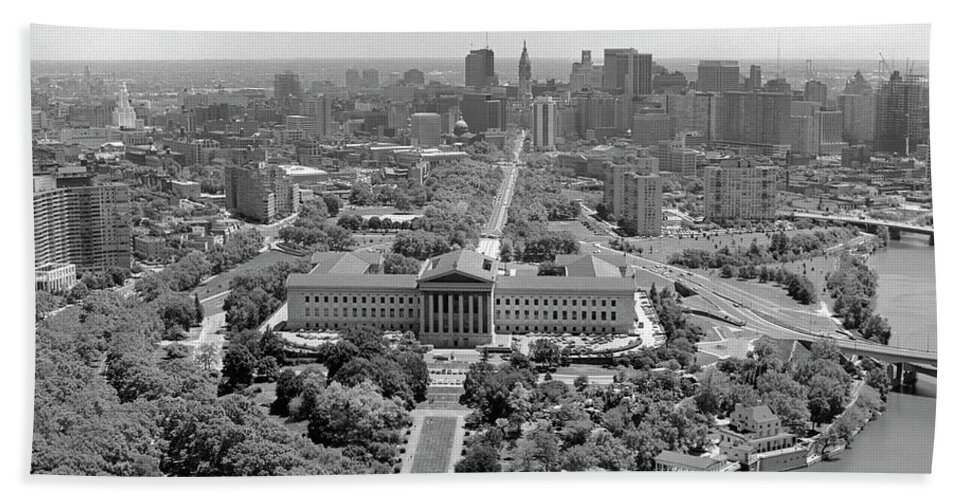
The Philadelphia Museum of Art extends its influence far beyond its galleries, actively engaging with the community through a variety of educational programs and resources. These initiatives are designed to foster a deeper understanding and appreciation of art across diverse audiences. Here’s a closer look at how the museum bridges the gap between art and education:
Professional Development for Educators
- Programs Offered: The museum provides comprehensive professional development programs for teachers of all subjects and grade levels. This includes the Visual Arts as a Source for Teaching (VAST) Summer Seminar and opportunities to earn credit hours through participation.
- Workshops: Interactive educator workshops are available throughout the year, both in-person and online, tailored to help teachers integrate art into their curriculum effectively.
- Accreditation: Recognized as an approved Art 48/continuing professional development provider in Pennsylvania and New Jersey, the museum ensures that educators receive valuable and accredited training.
Educational Resources and Programs
- Virtual Lessons and Materials: A wide range of resources, including virtual lessons and exhibition materials, are available to bring classroom lessons to life. These resources cover various subjects like Critical Thinking, Language Arts, and STEAM, and are tailored to different grade levels from Preschool to Higher Education.
- Featured Resources: Among the standout offerings are the American Art 1650-1850 Booklet and Art Speaks Teacher Resource, designed to enhance the educational experience.
- Community and School Engagement: The museum doesn’t just wait for visitors; it reaches out. With programs like the Delphi After School Art Club and school tours, the museum impacts over 150 Philadelphia schools. Additionally, Pay What You Wish hours and partnerships with community organizations like Project HOME aim to make art accessible to all.
Digital Engagement and Accessibility
- Outreach During the Pandemic: Leveraging digital platforms, the museum connected with the community virtually, offering an array of online resources and programs. This initiative saw a significant increase in online engagement, with a 22% rise in visits to collection pages.
- Online Booking and Virtual Attendance: The shift towards online booking and the presentation of virtual programs have demonstrated the museum’s adaptability and commitment to accessibility, with 67% of tickets booked online in advance in fiscal year 2021.
Through these efforts, the Philadelphia Museum of Art not only enriches the cultural landscape of Philadelphia but also plays a pivotal role in education and community engagement. By offering a multitude of resources and programs, the museum ensures that the beauty and depth of art are accessible to everyone, fostering lifelong learning and appreciation for the arts.
Throughout its illustrious history, the Philadelphia Museum of Art has made an indelible mark on the cultural and artistic landscape, not only of Philadelphia but of the global community as a whole. Through its expansive collections that span centuries of human creativity, notable exhibitions that delve into various art movements and eras, and its monumental architectural achievements, the museum has established itself as a beacon of art education and appreciation. Its commitment to inclusivity and engagement through educational programs and community outreach further cements its status as a pivotal institution in bridging the past with the present and future of art.
As we reflect on the museum’s contributions to the art world and its community, it’s clear that the Philadelphia Museum of Art embodies a dynamic blend of history, artistry, and innovation. The museum not only offers a window into the myriad expressions of human creativity but also stands as an advocate for the transformative power of art. Its ongoing commitment to accessibility, education, and engagement ensures that art remains a vital and accessible part of our lives, inspiring future generations to explore, understand, and cherish the rich tapestry of global art heritage.
FAQs
What are some interesting details about the Philadelphia Museum of Art? The Philadelphia Museum of Art boasts an internationally acclaimed collection that includes over 240,000 objects, representing a chronological span of 4,000 years. Additionally, the Museum’s Library and Archives hold another 200,000 items. Notably, 65% of the museum’s treasures were received as donations, highlighting its status as a “collection of collections.”
Which exhibits should I make sure to see at the Philadelphia Museum of Art? When visiting the Philadelphia Museum of Art, you won’t want to miss several remarkable pieces. Highlights of the museum’s collection include a Rogier van der Weyden altarpiece, “The Large Bathers” by Cezanne, a variety of works by Philadelphia’s own Thomas Eakins, and Marcel Duchamp’s famous mixed-media work “Bride Stripped Bare by her Bachelors” (also known as “The Large Glass”), which is displayed exactly as Duchamp himself installed it.
What should I consider before visiting an art museum? Before heading to an art exhibit, it’s wise to take a few preparatory steps: First, visit the exhibit’s official website to gather information. Next, plan your visit’s itinerary. It can also be beneficial to research the artists whose work you’ll be viewing. Bringing a notepad and pen can enhance your experience, as it allows you to jot down thoughts or observations. Lastly, be prepared to spend a considerable amount of time in front of each artwork to truly appreciate it.
How much time should I allocate for a visit to the Philadelphia Museum of Art? The amount of time you’ll want to spend at the Philadelphia Museum of Art can vary greatly depending on your interest in art. For art enthusiasts, a visit could last anywhere from 4 to 6 hours or potentially even longer. However, if art is more of a casual interest, a minimum of 2 hours should suffice. Remember to take advantage of the museum’s “pay what you wish” policy on Wednesdays after 5 pm and the first Sunday of every month for a more budget-friendly experience. For more information, you can visit the museum’s website here.
